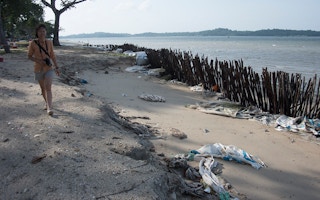The harmful effects of microplastics on the marine environment are widely documented. But now a new study says the tiny plastic debris acts as a carrier for pollutants resistant to environmental degradation, adding to the risks to animal and human health.
Microplastics are defined as pieces of plastic less than five millimetres in length, and include remnants of larger plastic items that have degraded, as well as polyethylene microbeads used in some health and beauty products.
The plastic pellets, often derived from synthetic clothing, vehicle tyres, bags, cups and other discarded waste, are commonly found on beaches and in oceans around the world.
A team of Brazilian researchers studied samples of microplastics collected along a 39-kilometre stretch of the Paraná State coastline, in southern Brazil.
Attached to the debris, they identified persistent organic pollutants — very stable compounds resistant to chemical and biological degradation — such as polychlorinated biphenyls (PCBs), and polycyclic aromatic hydrocarbons (PAHs).
These pollutants stem from chemical processes linked to oil exploration and transport, and are formed when coal, oil, wood, or tobacco is burned.
Alexander Turra, a biologist at the University of São Paulo’s Oceanographic Institute, and co-author of the study published this month in the journal Chemosphere, explains that when marine organisms ingest these microplastics, the pollutant particles get detached from them, contaminating organisms’ tissues and harming their nervous and hormonal systems.
“The resins contained in microplastics are able to attract pollutants, especially poisonous organic compounds,” Turra told SciDev.Net. “By doing so, these plastic pellets become sponges for dirt, acting as vectors of the organic compounds, spreading pollution of marine wildlife, and reducing their growth, reproduction and mobility.”
These pollutants, Turra added, are absorbed by tiny organisms and move up through the food chain.
“A zooplankton that consumes a microscopic piece of microplastic filled with PAHs may be eaten by a larger organism, which in turn feeds others of increasing size until the pollutant reaches larger predators fished and consumed by humans,” he said.
Plastic pollution is a devastating problem for marine life, with the UN Environment Programme estimating that about 8 million tonnes of plastic waste is dumped into the seas every year.
“
The resins contained in microplastics are able to attract pollutants, especially poisonous organic compounds.
Alexander Turra, biologist, Oceanographic Institute, University of São Paulo
About 90 per cent of the plastics that filter into the oceans come from just 10 of the world’s rivers which serve as conduits from urban areas, the agency says on its website.
Although plastic waste per person is highest in high-income countries, most mismanaged waste tends to arise from low-to-middle-income countries, where waste management systems have not kept pace with growing populations and industrialisation.
Turra is one of only a few researchers working on this issue in Brazil. In an ongoing survey, he estimates that about 30 tonnes of plastic pellets are present on the beaches of the Santos and São Vicente basin on the São Paulo coastline alone.
“This finding is rather concerning, given that Brazil’s southern beaches of Paraná coastline are often considered relatively pristine and free from the influence of human impact,” he said.
Denis Moledo de Souza, an oceanographer at the State University of São Paulo, told SciDev.Net: “The results are worrying because if pellets carry pollutants, which can cause toxicity in the fauna, we have an additional problem to the simple physical effect of the presence of the pellets, especially in the areas where they accumulate, such as beaches and mangroves.”
He added: “As the authors point out, it is possible many of these plastic pellets may have travelled from distant regions such as Santos, which has quite intense port activities with ships and boats that constantly release oil-related compounds into the sea.”
Turra hopes to monitor these and other beaches in Brazil and elsewhere, together with researchers from the International Pellet Watch, a global programme launched in 2005 to monitor the scale of contamination of the oceans by microplastics. It brings together volunteers from 80 countries.
“We aim to pick up and collect more information about this type of contamination so we can develop well-structured conservation strategies for marine and coastal environments,” he concluded.
This article was originally published on SciDev.Net. Read the original article.










